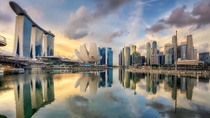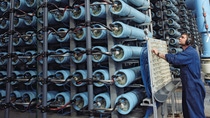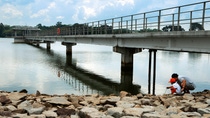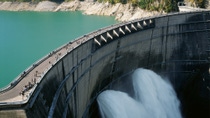The thirst of cities

Big cities around the world are facing enormous challenges as new residents stream into these metropolitan areas every day on the wave of global urbanization. But the existing infrastructure for water and sewage is often already at its limits. How can cities quench their growing thirst?
Necessity is the mother of invention and, after years of drought, the Californian city of San Diego was certainly in need. Between 1900 and 1916, barely a drop of rain fell in the city and the municipal water reservoirs were almost empty. In desperation, the city council offered the ‘rainmaker’ Charles Hatfield $10,000 if he could get the clouds to shed their tears with his rainmaking method. He started work in January 1916 – and soon thereafter the city experienced one of its worst floods of the 20th century. Facing death threats, Hatfield left the city and the council began looking for other sources of water. In late 1946, San Diego joined the Metropolitan Water District of Southern California and, in so doing, gained access to the Colorado River.
Since then, expensive water imports have been the main pillar of San Diego’s water management, according to the authors of a recent U.S. study.* Four-fifths of the city’s water comes from the Colorado River and the Bay-Delta; the water is transported into the city through aqueducts. The consequences of this strong dependency are already foreseeable.

Where will cities draw their water from in the future? How can cities ensure that their residents will have sufficient water for drinking, cooking, washing and hygiene ten, 20 or 50 years from now? Water is also a safety issue because it is needed to put out fires. In addition, water is necessary for industrial uses, such as producing goods or operating machines and plants. Without functioning water and sewage systems, economic development can be jeopardized. It is estimated that cities are responsible for 80% of global economic growth, so urban water deficits come at a very high cost. For example, growing water problems are costing China around 2.3% of its annual gross domestic product, as a study published in 2007 by the World Bank revealed.
This is an immense challenge. “We are at risk of losing the fight for access to water and sanitation facilities in many cities,” water expert Anders Berntell warned participants at the World Water Week in Stockholm, Sweden, in 2011. More than half of the Earth’s population already lives in urban metropolitan areas; by the middle of the century, this figure will be 70%. Around 9.6 billion people are expected to live on this planet by then, according to estimates from the United Nations (U.N.). Strong growth will especially be seen in the cities of India, China, Nigeria, the United States and Indonesia, the U.N. says.
“We are at risk of losing the fight for access to water and sanitation facilities in many cities.”
Anders Berntell, Water Expert
In many places, water consumption is already growing faster than the available resources can supply. Falling groundwater levels, empty riverbeds, dried-up reservoirs – water shortages are increasingly making the headlines, and it is no longer just a phenomenon seen in drought-prone countries. Even urbanites in industrialized countries are experiencing water shortages. Following two unusually dry years, strict water-saving measures were imposed in some areas of Great Britain in the spring of 2012. Watering the lawn or washing a car using a hose were punishable by a fine; in London, the fountains were turned off. And after a long dry period, in 2008, Barcelona even had to import tankers full of drinking water. This measure was expensive and not good for the city’s image. According to critics, it was necessary because the city had failed to increase its water supply capacities quickly enough to keep up with the sharp growth in population.

Seawater: the source of the future
One year later, a seawater desalination plant was inaugurated in nearby El Prat de Llobregat. With a daily capacity of 200,000 cubic meters, it should be able to meet the drinking water needs of about one‑quarter of the population of the Barcelona metropolitan region. Desalination of seawater is a popular option for coastal cities around the world. One example can be found in the town of Nungua, about 12 kilometers from the Ghanaian capital of Accra. Once completed, a desalination plant under construction there should produce enough drinking water for around half a million people each day. The plant will also be using ultrafiltration technology from inge®, a Bavarian subsidiary of BASF (also see article The new source).
According to the forecasts of sector specialists Global Water Intelligence (GWI), three times more people will meet their water needs through desalination technologies in 2030 than do so today. The number of plants is expected to multiply by 2050, the GWI experts predict. The projects are already being constructed on a gigantic scale. For example, a plant that recently started operations in Melbourne, Australia, can supply around 440,000 cubic meters of desalinated water daily. But desalination has its price: Despite great strides in technology, desalinated seawater is still a comparatively expensive and energy-intensive option compared to conventionally abstracted drinking water. This is one more reason to use water carefully.
Many cities are far from using water carefully. Some water companies postpone repairs. Instead of fixing leaks, they only take action when pipes break. As a result, millions and millions of liters of drinking water trickle away without being used. A vivid illustration of the consequences of overly wasteful water consumption can be found in Mexico City, a metropolis of millions which is gaining around 300,000 new residents every year. After decades of overexploitation of its groundwater, the city is sinking – the historical city center is now approximately 9 meters lower than it was in 1900. Around 62,000 liters of drinking water are consumed in the Mexican capital every second. As much as 40% of this amount is lost through the antiquated water pipes. And this is water that has first been pumped from as far as 300 meters below the city’s surface, or transported from 200 kilometers away and over 1,100 meters of altitude difference. On the other hand, entire city neighborhoods are flooded during heavy rains. The city wants to solve this flooding problem with the major project “Túnel Emisor Oriente.”
Costing $1.2 billion (€0.9 billion), this 62 kilometer-long wastewater tunnel with a diameter of 7 meters should be completed in 2016. Although a local environmental organization, Isla Urbana, has recommended using rainwater as well, city planners have not been receptive to this idea so far.
In cities in Southeast Asia in particular, “rainwater harvesting” is well established and this practice is also advocated by UN‑HABITAT, the United Nations Human Settlements Programme. In addition to Singapore, one of the most popular examples of this can be found in the Sumida district of Tokyo. For more than two decades, municipal policy here has supported the collection and reuse of rainwater. Residents can get subsidies for constructing rainwater storage tanks.
Some city buildings, such as the Tokyo Skytree – which opened in 2012 and, at 634 meters high, is the second-tallest building in the world – contain cisterns with filters in the lower basement levels. The water tank in the new broadcast tower holds around 2,600 cubic meters of water. It is fed by rainwater, which is used to cool the solar panels on the roof and flush the toilets; it also helps provide emergency flood control during heavy rains.
Contaminated land and rivers
The “dirty truth” about the oftentimes all too careless and thoughtless management of water is especially apparent when it comes to the issue of wastewater. Worldwide, 80% of urban wastewater is released directly into rivers, lakes or the sea without being treated – even in London, where millions of liters of untreated wastewater flow into the Thames during rainy weeks because the capacities of the treatment plants are overwhelmed. The situation is particularly dramatic in the cities in emerging and developing countries. In Buenos Aires, for example, the rivers are very polluted; in Kolkata, India, the population is struggling with fecal contamination and an elevated concentration of arsenic in the groundwater. The situation in China is also alarming: 90% of the groundwater in cities is contaminated, according to a recent study by the China Geological Survey. An analysis of 118 Chinese cities also found that 64% of the water sources were “heavily” polluted, while 33% were “mildly” polluted and only 3% fell under the category of “sanitary.”
According to international water expert Professor Asit Biswas, PhD, the real issue is not that there is not enough water, it is the poor quality of available resources. “The main problem is not physical scarcity of water, but its continued mismanagement! Unless water management can be improved significantly, the world’s water problem cannot be solved,” says the founder of the Third World Centre for Water Management in Mexico.
“The main problem is not physical scarcity of water, but its continued mismanagement! Unless water management can be improved significantly, the world’s water problem cannot be solved.”
Asit Biswas, Professor and international water expert
“Traditional water use models lead to water shortages,” says Dr. Max Maurer, a professor for urban water systems at the Institute of Environmental Engineering at the Swiss Federal Institute of Technology Zurich (ETH). The traditional European model of collecting all wastewater, including rainwater, in a sewage system and then processing it in a wastewater treatment plant is not a global solution, he believes. “We have to work on creating overall systems that are effective and flexible at the same time.
Sewers are a perfect solution for the inner city, but it is also important to develop alternatives that work on the outskirts of cities, in the slums,” Maurer says. A great example of this was the 2011 “Reinvent the Toilet Challenge” issued to universities by the Bill & Melinda Gates Foundation, he adds. Around 2.1 billion urban dwellers worldwide currently have no access to hygienic sanitary facilities, according to the foundation. The challenge in this competition was to design toilets that could capture and process human waste without piped water, sewer or electrical connections, and transform human waste into useful resources, while keeping costs below 5 U.S. cents per user per day. The Peepoo single-use toilet, for example, is a similar solution (see article "Better hygiene thanks to Peepoo"). Maurer stresses it will be a huge advance if we are able to “break the link between the toilet and water consumption, and process the waste materials to create valuable goods.”

Good water management conserves resources and is ecological. It seems this message is finally getting through – albeit slowly. Experts believe that tapping new water sources is important, but even more potential exists in water recycling. One of the pioneers in this area is Singapore. By 2060, the island state wants to meet up to 55% of its water demand with NEWater – wastewater that has been treated to bring it up to drinking water quality (see article "Charting new waters").
The London-based utility Thames Water is also considering recycling wastewater into drinking water and is conducting a survey to test the public’s receptiveness to this idea. Widespread acceptance of such a program is necessary, as was demonstrated a few years ago in Brisbane, Australia. The city was set to add recycled wastewater to its drinking water supply, but had to backtrack because the population simply could not be convinced that the water was pure enough to drink.
The same sort of problems should not be an issue for the water recycling strategy in the emirate of Qatar, which is set to host the soccer World Cup in 2022 and has one of the lowest rates of precipitation in the world. Recycled wastewater here is primarily used for irrigation in parks and green areas. Some 24,000 cubic meters of water are recycled using BASF’s ultrafiltration technology each day at the recently completed Doha North Sewage Treatment Works.
Interdisciplinary thinking
Clean drinking water, proper sanitation facilities and wastewater treatment plants will be essential to the future of cities. Solving urban water problems will require thinking outside the box – and this is where many fail. The lack of willingness to think and act in an interdisciplinary way is one of the main hurdles in water management, according to one of the conclusions of the Switch project, which was sponsored by the E.U. and involved 30 cities worldwide over a period of five years. A change of perspective is needed. Wastewater should be seen as a valuable resource rather than a problem and, as in Singapore, water reservoirs should be integrated into the urban fabric in a way that also allows them to serve as a recreational area for residents. This was also illustrated by Khoo Teng Chye, former CEO of Singapore’s national water agency PUB: “In order to be a sustainable city, we always have to be forward-looking, visionary and bold thinkers. We need innovations, not only in technology, but also with regard to how we approach integrated water management.”
Watch the videos to learn more about water management projects in Singpore and California:
* Brian D. Richter et al., Tapped Out: How Can Cities Secure Their Water Future?, Water Policy, 2013.
(Article: September 2013)



